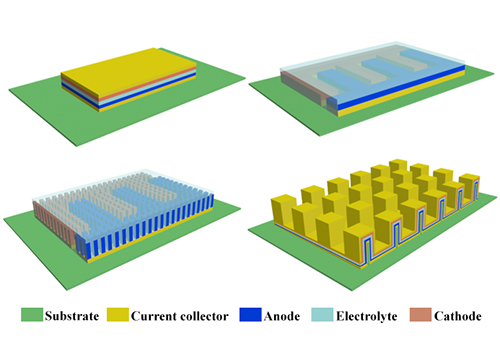A research group led by Prof. WU Zhong Shuai and Prof. BAO Xinhe from the Dalian Institute of Chemical Physics (DICP) of the Chinese Academy of Sciences reviewed the recent development and progress of planar microbatteries (MBs) and micro-supercapacitors (MSCs), and highlighted the future road of MBs and MSCs from 2D to 3D device geometry. The study was published in Advanced Materials.

Schematic of the classified four types of MBs and MSCs (Image by ZHENG Shuanghao)
The rapid development and further modularization of miniaturized and self-powered electronic systems have substantially stimulated the urgent demand for microscale electrochemical energy storage devices, e.g., MBs and MSCs.
Recently, planar MBs and MSCs, composed of isolated thin-film microelectrodes with extremely minimized ionic diffusion path and even free of separator on a single substrate, are becoming particularly attractive. It is because they can be directly integrated with microelectronic devices on the same side of one single substrate to act as a stand-alone microsized power source or complement miniaturized energy harvesting units.
This report highlighted the development and recent advances of planar MBs and MSCs from the fundamentals and design principle to the fabrication methods of two-dimensional (2D) and three-dimensional (3D) planar microdevices in both in-plane and stacked geometries.
It provided a comprehensive analysis of the primary aspects of electrode materials, electrolyte, device architecture, and microfabrication techniques that eventually affect the performance metrics of microscale energy storage devices. The technical challenges and prospective solutions for high-energy-density planar MBs and MSCs with multi-functionalities were proposed.
This work was supported by National Natural Science Foundation of China, National Key R&D Program of China, etc. (Text by ZHENG Shuanghao and HOU Xiaocheng)